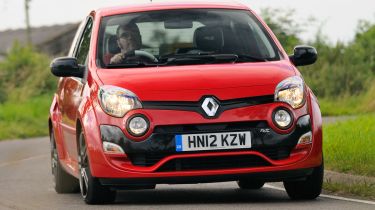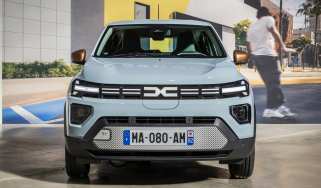Renaultsport Twingo 133
Does the facelifted hot hatch blast straight to the top of the class?
There’s no doubt the Renaultsport Twingo is huge fun on the right road, but it feels outdated next to the Suzuki. Although it’s more practical and comes with the brilliant 4+ package, the unrelenting ride is too much of a compromise. Plus, the interior upgrades don’t match the Swift’s and the looks divide opinion.
Renault is famed for its great small cars, so the second-generation Twingo was something of a disappointment when it launched in 2007. Lacklustre driving dynamics, a cheap cabin and plain looks have made it an also-ran in the city car class. However, the flagship Renaultsport version soon gained a cult following, thanks to its sharp handling and rev-hungry 1.6-litre engine.
The standard Twingo was given a facelift late last year, and now the Renaultsport has also been brought up to date. The regular car’s new front end is inspired by the DeZir concept, seen at the 2010 Paris Motor Show, but we think it looks rather fussy. Replacing the old model’s simple nose is a full-width grille, revised headlamps and a pair of high-set foglights – although these look a little too much like aftermarket items.
The Renaultsport version adds a bigger grille under the bumper, flared wheelarches and 16-inch alloys (the 17-inch wheels on our test car are a £500 option). At the back there’s a gloss black spoiler and diffuser, so the latest Twingo definitely looks sporty. Unfortunately, the standard car’s revised rear lights, which are split by the line of the tailgate, look a little odd and not at all sporty.
Used - available now

2020 BMW
5 Series Touring
71,000 milesAutomaticDiesel3.0L
Cash £22,500
2020 BMW
M2
36,380 milesAutomaticPetrol3.0L
Cash £31,995
2019 BMW
X6
65,650 milesAutomaticDiesel3.0L
Cash £20,500
2021 BMW
M240i
81,700 milesAutomaticPetrol3.0L
Cash £16,995Inside, the plastics have been improved and there’s a new stereo with gloss black trim. However, the Twingo doesn’t feel as well built as its Suzuki rival, and the doors close with a tinny clang rather than a solid thud. Large windows let in plenty of light, though, and space is good up front.
The sports seats are comfortable, too – even if you feel like you’re sitting on the car, rather than in it. It’s just a pity the driver’s doesn’t move back far enough, and the steering adjusts only for height, not reach.
In the rear, the two individual seats fold and slide back and forth independently, so you can maximise boot or passenger space, while a low load lip means it’s easy to get luggage in and out. Mechanically, the Renaultsport Twingo has been left unchanged, so you get the same eager 131bhp 1.6-litre engine with a 7,000rpm red line. The engine only really comes alive above 4,000rpm, but that’s no bad thing as it sounds great. Trouble is, you have to work the gearbox to keep the revs right, and our car had a notchy shift. Changing ratios in the Suzuki was more satisfying.
This also made it tricky to get the Twingo off the line cleanly, and it trailed the Swift by 1.2 seconds from 0-60mph, with a time of 9.5 seconds. In gear, the cars were evenly matched; the six-speed Suzuki was faster from 30-50mph, while the shorter-geared Renault won out from 50-70mph in fifth.
The Twingo’s engine is complemented by a razor-sharp chassis. There’s plenty of grip in corners thanks to the stiff set-up, while the steering is direct with great feedback. But the wheel writhes when cornering hard on bumpy roads, and the suspension is unrelenting.
For £700, the even firmer Cup-spec chassis lowers and stiffens the set-up further, but we’d recommend that only for diehard track day fans. And this is the main problem with the Twingo. While it’s hugely entertaining on the right road, you have to work it hard to get the most out of it, and its racy character dominates the rest of the driving experience. The short ratios mean that at 70mph the Twingo buzzes along at 3,600rpm, and around town the stiff suspension sends it bouncing over speed humps and crashing into potholes.
The five-speed box also puts the car on the back foot in terms of running costs. Our 28.2mpg test fuel economy did include performance testing, but if you plan to drive the car every day you’re unlikely to get close to Renault’s claimed figure of 43.5mpg.
The Twingo is only slightly pricier than the Swift, at £13,565, although it has less kit and sits two insurance groups higher. However, it does get Renault’s 4+ package, which comprises four years’ warranty, breakdown cover, servicing and finance.



